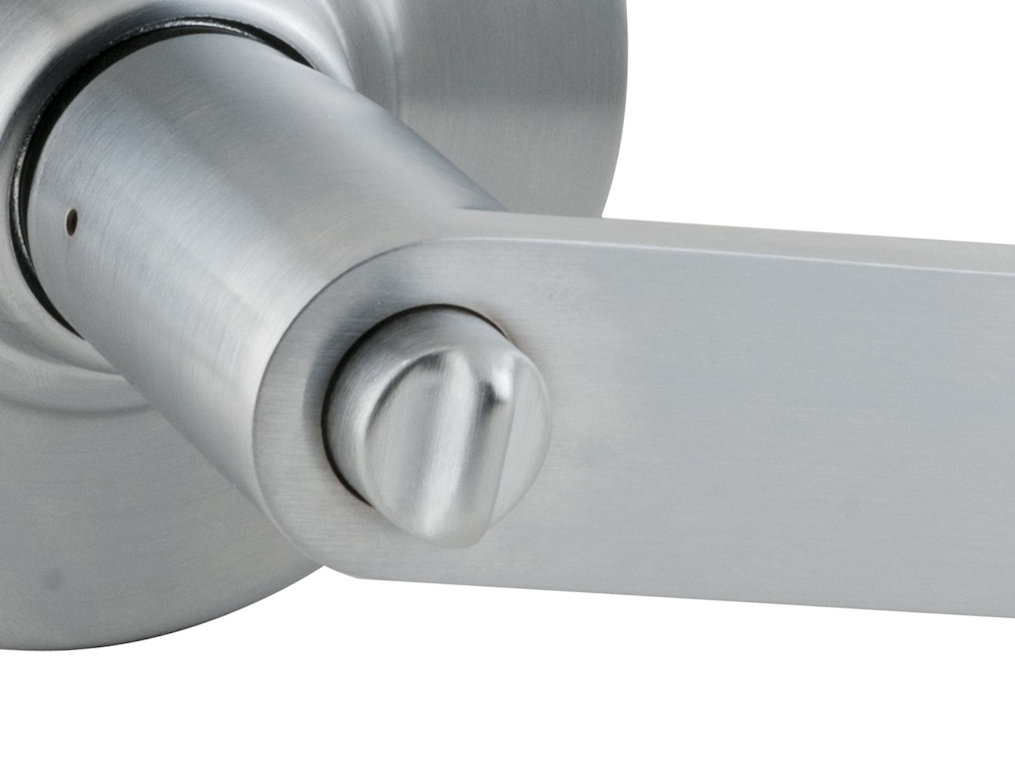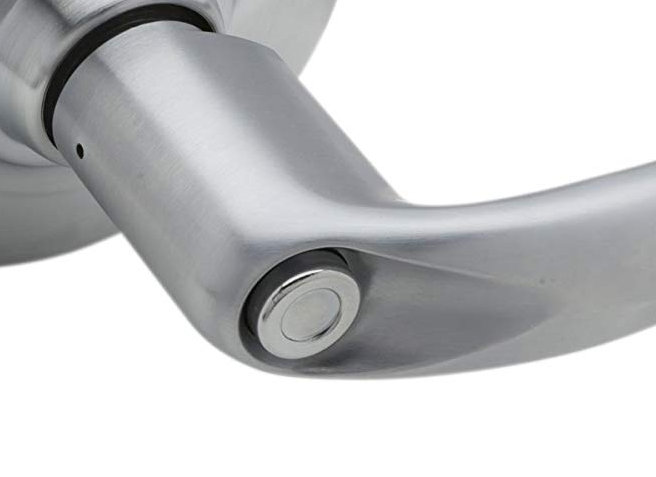Sometimes the model codes and standards aren’t specific enough for me to give a yes/no answer, and I can only give you my interpretation based on past experience. That’s the case with this question…
Are turn-buttons on cylindrical locks compliant with the accessibility standards?
Let’s start at the beginning. Mechanical cylindrical locks that are lockable from the inside have one of the following: 1) a push-button, 2) a turn-button, or 3) a key cylinder. The model codes and accessibility standards do not include prescriptive requirements for these operable parts, but the hardware must operate with no tight grasping, pinching, or twisting of the wrist.
Push-buttons are considered compliant with the accessibility standards, because they do not require tight grasping, pinching, or twisting of the wrist to operate. Turn-buttons, however, have been rejected by some code officials because they require tight grasping, pinching, and/or twisting of the wrist.
With most commercial lock functions that incorporate a turn-button, the button actually functions as both a push-button and a turn-button. The lock can be locked by simply pushing the turn-button; the building occupant does not have to turn the button to lock or unlock the door.* The button only needs to be turned in order to maintain the locked condition when the latch is retracted by a key or when the inside lever is turned. If the turn-button is pushed but not turned, the lock will typically unlock when the key is used in the outside lever, or when the inside lever is turned.
The argument could be made that pushing the turn-button can be accomplished without tight grasping, pinching, or twisting of the wrist, and therefore the turn-button is compliant with the accessibility standards. However, in my experience, some AHJs take one look at the turn-button and deem it non-compliant. In most cases I avoid specifying a lock function with a turn-button, to minimize problems in the field.
You may be wondering why a lockset with a key cylinder is acceptable, when it clearly requires tight grasping, pinching, and or twisting to turn a key in the cylinder, as well as dexterity to insert the key. The reason key cylinders are not prohibited by the codes and standards is because keys are not considered an operable part of the lock. Only operable parts are addressed by the accessibility standards, not the keys and access control credentials used to operate the locks.
Do you have experience with this issue? If you do, please share it in the reply box below.
*There are some lock functions, particularly on residential locks, that require the turn-button to be turned to lock the door and turned the other way to unlock the door and allow the lever to be turned for egress. These are not compliant where the codes and standards require one operation to unlatch the door, or where hardware must be operable with no tight grasping, pinching, or twisting of the wrist.
You need to login or register to bookmark/favorite this content.







Most of the hotel work we do must have push button only on guest bathrooms. I believe that is being driven by the hotel chain standards.
Hi Bob –
I imagine with a privacy set they would typically want it to unlock when someone opens the door, so push-button makes sense for functionality in addition to accessibility.
– Lori
I may be missing something here but my understanding of ADA was for egress not locking. Both turn and push button allow free egress so I don’t see an issue. Wouldn’t this be the same as a mortise with a dead bolt? It provides egress with one motion but locks from the inside with a twist of the thumb turn.
Hi Fred –
The accessibility standards apply to both access and egress. The turn-button that also functions as a push-button is a grey area, because it will function as required by the standards when pushing the button, but turning the button requires tight grasping/pinching/twisting. The difference with a mortise lock is that a larger thumbturn can be used to allow the bolt to be projected without tight grasping/pinching/twisting.
– Lori
Hi Lori
Don’t mean to be a pain but is there an ADA requirement to lock or unlock the door? I know ADA has to provide access to an unlocked door for entry, and free egress to exit, but is there an ADA requirement to lock or unlock a door? That is the function of the button or turn on a lock set. I see the button serving the same function as a Key, Swipe, or Keypad. They change the status of the lock or the way the door operates not the accessibility of the opening.
You’re not being a pain! 🙂 The ADA standards say this:
404.2.7 Door and Gate Hardware. Handles, pulls, latches, locks, and other operable parts on doors and gates shall comply with 309.4. Operable parts of such hardware shall be 34 inches (865 mm) minimum and 48 inches (1220 mm) maximum above the finish floor or ground. (There’s more regarding sliding doors, existing doors, etc.)
In Section 309.4 (referenced above), it says this:
309.4 Operation. Operable parts shall be operable with one hand and shall not require tight grasping, pinching, or twisting of the wrist. The force required to activate operable parts shall be 5 pounds (22.2 N) maximum.
The accessibility standards don’t limit the requirements to operable parts used for egress. Most AHJs apply the requirements to any operable part on the hardware, whether it’s a thumbturn, keypad, lever, or something else that is used to operate the hardware.
– Lori
hi
I need a standard for design Turn-Buttons vs. Push-Buttons .. i am interested in internal mechanical design